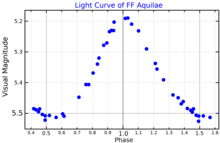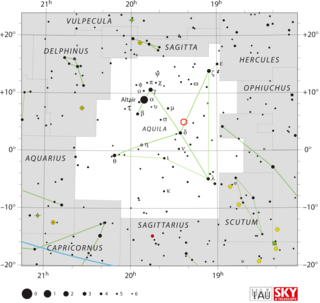
V1494 Aquilae or Nova Aquilae 1999 b was a nova which occurred during 1999 in the constellation Aquila and reached a brightness of magnitude 3.9 on 2 December 1999. making it easily visible to the naked eye. The nova was discovered with 14×100 binoculars by Alfredo Pereira of Cabo da Roca, Portugal at 18:50 UT on 1 December 1999, when it had a visual magnitude of 6.0.

W Sagittarii is a multiple star system star in the constellation Sagittarius, and a Cepheid variable star.

X Sagittarii is a variable star and candidate binary star system in the southern constellation of Sagittarius, near the western constellation boundary with Ophiuchus. It has a yellow-white hue and is visible to the naked eye with an apparent visual magnitude that fluctuates around 4.54. The star is located at a distance of approximately 950 light years from the Sun based on parallax, and is drifting closer with a radial velocity of −10 km/s. The star has an absolute magnitude of around −2.85.

21 Aquilae is a solitary variable star in the equatorial constellation of Aquila. It has the variable star designation V1288 Aql; 21 Aquilae is its Flamsteed designation. This object is visible to the naked eye as a dim, blue-white hued star with a baseline apparent visual magnitude of about 5.1. The star is located at a distance of around 680 light-years from Earth, give or take a 20 light-year margin of error. It is moving closer to the Earth with a heliocentric radial velocity of –5 km/s.
14 Aquilae is a probable spectroscopic binary star system in the equatorial constellation of Aquila. 14 Aquilae is the Flamsteed designation though it also bears the Bayer designation g Aquilae. It is visible to the naked eye as a dim, white-hued star with an apparent visual magnitude of 5.42, and it is located at a distance of approximately 500 light-years from Sun. The star is moving closer to the Earth with a heliocentric radial velocity of −39 km/s, and may come as close as 136 light-years in around 3.5 million years.

28 Aquilae, abbreviated 28 Aql, is a star in the equatorial constellation of Aquila. 28 Aquilae is its Flamsteed designation though it also bears the Bayer designation A Aquilae, and the variable star designation V1208 Aquilae. It has an apparent visual magnitude is 5.5, making this a faint star that requires dark suburban skies to view. The annual parallax shift of 9.6 mas means this star is located at a distance of approximately 340 light-years from Earth.

10 Aquilae is a star in the equatorial constellation of Aquila. 10 Aquilae is the Flamsteed designation. It has an apparent visual magnitude of 5.9 and thus is a faint star that is just visible to the naked eye in dark skies. The brightness of this star is diminished by 0.17 in visual magnitude from extinction caused by interstellar gas and dust. Based on an annual parallax shift of 13.45 mas, the distance to this star is around 240 light-years.

RT Aurigae is a yellow supergiant variable star in the constellation Auriga, about 1,500 light years from Earth.
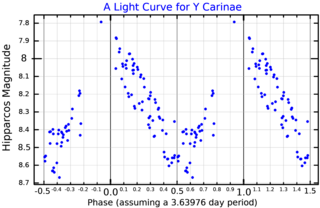
Y Carinae is a Classical Cepheid variable, a type of variable star, in the constellation Carina. Its apparent magnitude varies from 7.53 to 8.48.

V Centauri is a Classical Cepheid variable, a type of variable star, in the constellation Centaurus. It is approximately 2,350 light-years away based on parallax.
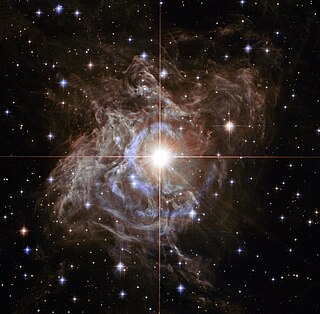
RS Puppis is a Cepheid variable star around 6,000 ly away in the constellation of Puppis. It is one of the biggest and brightest known Cepheids in the Milky Way galaxy and has one of the longest periods for this class of star at 41.5 days.

U Aquilae is a binary star system in the constellation Aquila, Located approximately 614 parsecs (2,000 ly) away from Earth.

V1472 Aquilae is a triple star system in the equatorial constellation of Aquila. It is a variable star that ranges in brightness from 6.36 down to 6.60. The system is located at a distance of approximately 780 light years from the Sun based on parallax. It is a high-velocity star system with a radial velocity of −112 km/s.

TT Aquilae is a Classical Cepheid variable star in the constellation Aquila.

Classical Cepheids are a type of Cepheid variable star. They are young, population I variable stars that exhibit regular radial pulsations with periods of a few days to a few weeks and visual amplitudes ranging from a few tenths of a magnitude up to about 2 magnitudes. Classical Cepheids are also known as Population I Cepheids, Type I Cepheids, and Delta Cepheid variables.

T Vulpeculae is a possible binary star system in the northern constellation of Vulpecula, near the star Zeta Cygni, close to the pair 31 Vulpeculae and 32 Vulpeculae. It is visible to the naked eye with an apparent visual magnitude that ranges around 5.75. The distance to this system is around 1,900 light years, as determined from its annual parallax shift of 1.67 mas.

SV Vulpeculae is a classical Cepheid variable star in the constellation Vulpecula. It is a supergiant at a distance of 8,700 light years.

U Vulpeculae is a variable and binary star in the constellation Vulpecula.

W Aquilae is a variable star in the constellation of Aquila. It is a type of evolved star known as an S-type star. Due to its relatively close distance of 1,200 light-years and equatorial location, it is easy to observe and heavily studied.
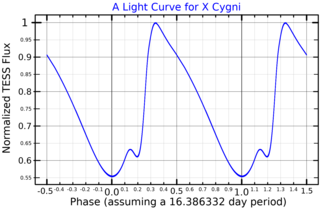
X Cygni is a variable star in the northern constellation of Cygnus, abbreviated X Cyg. This is a Delta Cephei variable that ranges in brightness from an apparent visual magnitude of 5.85 down to 6.91 with a period of 16.386332 days. At it brightest, this star is dimly visible to the naked eye. The distance to this star is approximately 628 light years based on parallax measurements. It is drifting further away with a radial velocity of 8.1 km/s. This star is a likely member of the open cluster Ruprecht 173.
